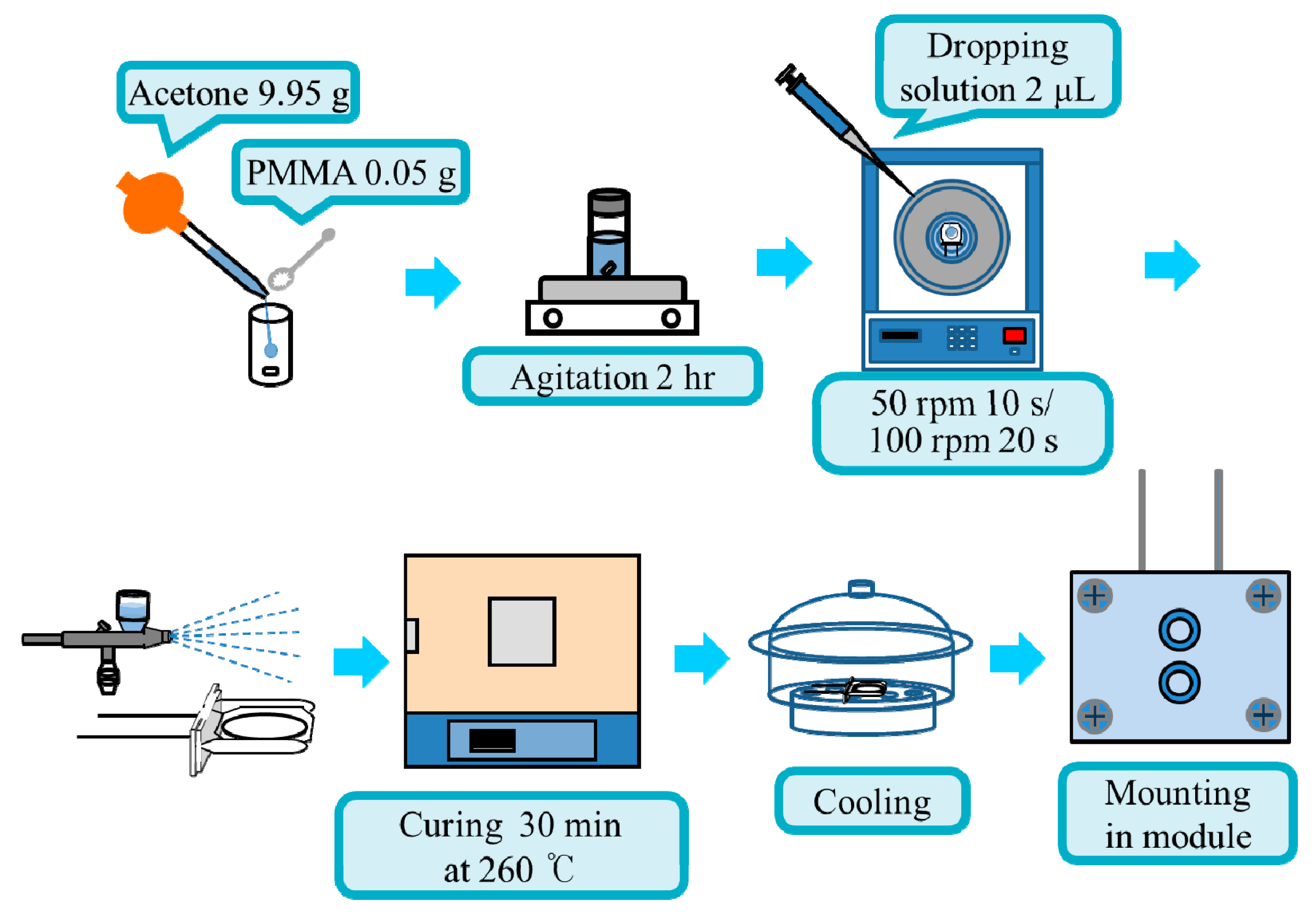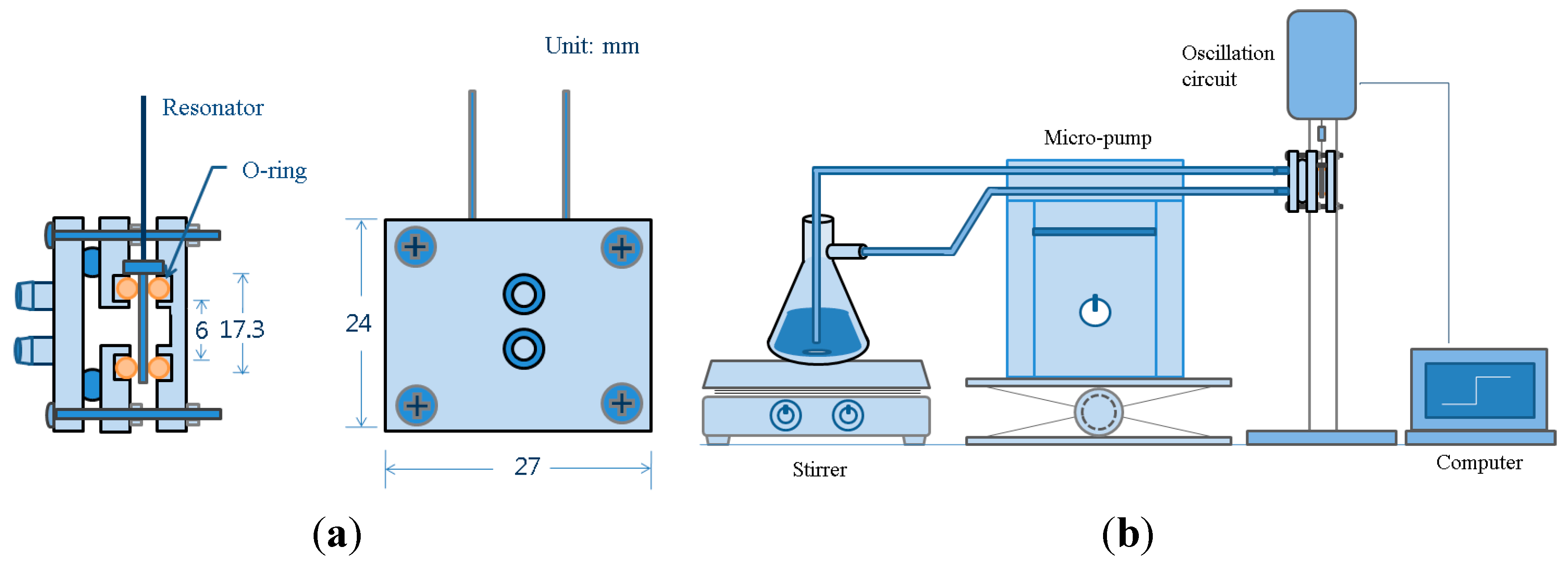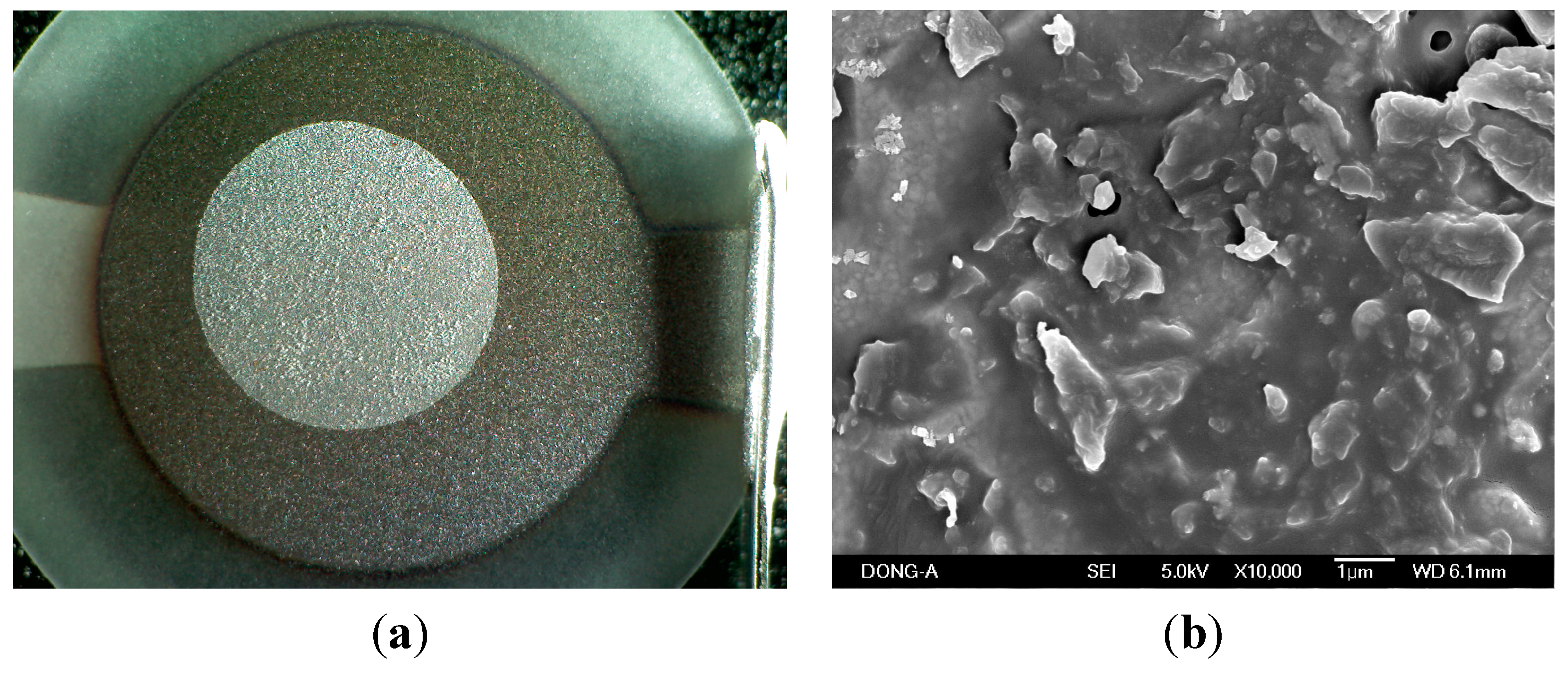In-Line Measurement of Water Contents in Ethanol Using a Zeolite-Coated Quartz Crystal Microbalance
Abstract
:1. Introduction
2. Experimental Section
2.1. Materials
2.2. Instruments
2.3. Equipment


2.4. Procedures
3. Results and Discussion
| Zeolite | Formula | Si/Al Ratio | BET Area (m2/g) | Pore Volume (cm3/g) |
|---|---|---|---|---|
| A-3 | (1-X)Na2O·XK2O·Al2O3·2SiO2 (X > 0.4) | 1 | – | – |
| A-5 | (1-X)Na2O·XK2O·Al2O3·2SiO2 (X > 0.7) | 1 | 600 | 0.3 |
| Na-Y | Na2O·Al2O3·5.5SiO2 | 11 | 810 | 0.4 |
| Na-MOR | Na2O·Al2O3·18SiO2 | 36 | 470 | 0.23 |
| H-MOR | 0.12Na2O·Al2O3·240SiO2 | 400 | 550 | 0.25 |




4. Conclusions/Outlook
Acknowledgments
Author Contributions
Conflicts of Interest
References
- Zhang, L.; Yang, B.; Zhang, W. Vapor-Liquid Equilibrium of Water plus Ethanol plus Glycerol: Experimental Measurement and Modeling for Ethanol Dehydration by Extractive Distillation. J. Chem. Eng. Data 2015, 60, 1892–1899. [Google Scholar] [CrossRef]
- Nielsen, J.; Andreasen, M.B.; Pedersen, M.; Rasmussen, M.K. Towards Fast In-line Measurement of Water Activity. Int. J. Thermophys. 2015, 36, 577–588. [Google Scholar] [CrossRef]
- Hudovornik, G.; Korasa, K.; Vrecer, F. A study on the applicability of in-line measurements in the monitoring of the pellet coating process. Eur. J. Pharm. Sci. 2015, 75, 160–168. [Google Scholar] [CrossRef] [PubMed]
- Rahman, M.; Hakansson, U.; Wiklund, J. In-line rheological measurements of cement grouts: Effects of water/cement ratio and hydration. Tunn. Undergr. Space Technol. 2015, 45, 34–42. [Google Scholar] [CrossRef]
- Bruno, T.J.; Wolk, A.; Naydich, A. Analysis of Fuel Ethanol Plant Liquor with the Composition Explicit Distillation Curve Method. Energy Fuels 2009, 23, 3277–3284. [Google Scholar] [CrossRef]
- Fujiwara, E.; Takeishi, R.T.; Hase, A.; Ono, E.; Santos, J.S.; Suzuki, C.K. Real-time optical fibre sensor for hydro-alcoholic solutions. Measur. Sci. Technol. 2010, 21. [Google Scholar] [CrossRef]
- Brown, R.J.C.; Keates, A.C.; Brown, A.S. Optimised determinations of water in ethanol by encoded photometric near-infrared spectroscopy: A special case of sequential standard addition calibration. Anal. Chim. Acta 2010, 690, 47–52. [Google Scholar] [CrossRef] [PubMed]
- Dion, J.R.; Burns, D.H. Simultaneous determination of alcohol and carbohydrate content in commercial beverages by ultrasound frequency analysis. Talanta 2011, 86, 384–392. [Google Scholar] [CrossRef] [PubMed]
- Hoog-Antonyuk, N.A.; Olthuis, W.; Mayer, M.J.J.; Yntema, D.; Miedema, H.; van den Berg, A. On-line fingerprinting of fluids using coaxial stub resonator technology. Sens. Actuators B Chem. 2012, 163, 90–96. [Google Scholar] [CrossRef]
- Trofimov, V.A.; Varentsova, S.A. An Effective Method for Substance Detection Using the Broad Spectrum THz Signal: A “Terahertz Nose”. Sensors 2015, 15, 12103–12132. [Google Scholar] [CrossRef] [PubMed]
- Gente, R.; Koch, M. Monitoring leaf water content with THz and sub-THz waves. Plant Methods 2015, 11. [Google Scholar] [CrossRef] [PubMed]
- Sophocleous, M.; Atkinson, J.K. A novel thick-film electrical conductivity sensor suitable for liquid and soil conductivity measurements. Sens. and Actuators B Chem. 2015, 213, 417–422. [Google Scholar] [CrossRef]
- Ribeiro, M.S.; Angnes, L.; Rocha, F.R.P. A Simple and Fast Procedure for in situ Determination of Water in Ethanol Fuel. J. Brazilian Chem. Soc. 2013, 24, 418–422. [Google Scholar] [CrossRef]
- Jaikang, P.; Grudpan, K.; Kanyanee, T. Conductometric determination of ammonium ion with a mobile drop. Talanta 2015, 132, 884–888. [Google Scholar] [CrossRef] [PubMed]
- Joung, O.J.; Kim, Y.H. Dew point measurement for organic vapor mixture using a quartz crystal sensor. Sens. Actuators B Chem. 2006, 113, 335–340. [Google Scholar] [CrossRef]
- Kim, B.C.; Kim, Y.H. Monitoring Photopolymerization of Trimethylolpropane Triacrylate Using a Quartz Crystal Resonator. J. Polym. Sci. Part A Polym. Chem. 2011, 49, 4578–4585. [Google Scholar] [CrossRef]
- Kim, Y.H. On-line measurement of monomer concentration in UV photopolymerization using a quartz crystal resonator. Korean J. Chem. Eng. 2011, 28, 1632–1635. [Google Scholar] [CrossRef]
- Kim, Y.H. Measurement of thermal property of polystyrene using dual quartz crystal resonators. Korean J. Chem. Eng. 2011, 28, 1924–1926. [Google Scholar] [CrossRef]
- Hwang, M.-J.; Shim, W.-G.; Yang, C.Y.; Moon, H. Preparation of Molecularly Imprinted Polymers for the Detection of Aromatic Hydrocarbons. J. Nanosci. Nanotechnol. 2011, 11, 7206–7209. [Google Scholar] [CrossRef] [PubMed]
- Kasai, N.; Sugimoto, I.; Nakamura, M.; Katoh, T. Odorant detection capability of QCR sensors coated with plasma deposited organic films. Biosens. Bioelectron. 1999, 14, 533–539. [Google Scholar] [CrossRef]
- Nakamura, K.; Nakamoto, T.; Moriizumi, T. Classification and evaluation of sensing films for QCM odor sensors by steady-state sensor response measurement. Sens. Actuators B Chem. 2000, 69, 295–301. [Google Scholar] [CrossRef]
- Procek, M.; Stolarczyk, A.; Pustelny, T.; Maciak, E. A Study of a QCM Sensor Based on TiO2 Nanostructures for the Detection of NO2 and Explosives Vapours in Air. Sensors 2015, 15, 9563–9581. [Google Scholar] [CrossRef] [PubMed]
- Sartore, L.; Barbaglio, M.; Penco, M.; Bergese, P.; Bontempi, E.; Colombi, P.; Depero, L.E. Polymer-Coated Quartz Crystal Microbalance Chemical Sensor for Heavy Cations in Water. J. Nanosci. Nanotechnol. 2009, 9, 1164–1168. [Google Scholar] [CrossRef] [PubMed]
- Yang, C.-Y.; Hwang, M.-J.; Ryu, D.-W.; Park, J.-H.; Ryu, M.-S.; Moon, H. A Quartz Crystal Microbalance-Based Sensor System Coated with Functional Polymers for SO2 and NO2 Detection. J. Nanosci. Nanotechnol. 2011, 11, 7189–7192. [Google Scholar] [CrossRef] [PubMed]
- Yang, Y.; Tu, Y.; Wang, X.; Pan, J.; Ding, Y. A Label-Free Immunosensor for Ultrasensitive Detection of Ketamine Based on Quartz Crystal Microbalance. Sensors 2015, 15, 8540–8549. [Google Scholar] [CrossRef] [PubMed]
- Funari, R.; Della Ventura, B.; Carrieri, R.; Morra, L.; Lahoz, E.; Gesuele, F.; Altucci, C.; Velotta, R. Detection of parathion and patulin by quartz-crystal microbalance functionalized by the photonics immobilization technique. Biosens. Bioelectron. 2015, 67, 224–229. [Google Scholar] [CrossRef] [PubMed] [Green Version]
- Kim, B.C.; Yamamoto, T.; Kim, Y.H. In-Line Measurement of Water Content in Ethanol Using a PVA-Coated Quartz Crystal Microbalance. Sensors 2014, 14, 1564–1575. [Google Scholar] [CrossRef] [PubMed]
- Dyer, A.; Faghihian, H. Diffusion in heteroionic zeolites: Part 2: Diffusion of water in heteroionic stilbites. Micropor. Mesopor. Mater. 1998, 21, 39–44. [Google Scholar] [CrossRef]
- Higgins, F.M.; de Leeuw, N.H.; Parker, S.C. Modelling the effect of water on cation exchange in zeolite A. J. Mater. Chem. 2002, 12, 124–131. [Google Scholar]
- Kanazawa, K.K.; Gordon, J.G. Frequency of a Quartz Microbalance in Contact with Liquid. Anal. Chem. 1985, 57, 1770–1771. [Google Scholar] [CrossRef]
© 2015 by the authors; licensee MDPI, Basel, Switzerland. This article is an open access article distributed under the terms and conditions of the Creative Commons Attribution license (http://creativecommons.org/licenses/by/4.0/).
Share and Cite
Kim, B.C.; Yamamoto, T.; Kim, Y.H. In-Line Measurement of Water Contents in Ethanol Using a Zeolite-Coated Quartz Crystal Microbalance. Sensors 2015, 15, 27273-27282. https://doi.org/10.3390/s151027273
Kim BC, Yamamoto T, Kim YH. In-Line Measurement of Water Contents in Ethanol Using a Zeolite-Coated Quartz Crystal Microbalance. Sensors. 2015; 15(10):27273-27282. https://doi.org/10.3390/s151027273
Chicago/Turabian StyleKim, Byoung Chul, Takuji Yamamoto, and Young Han Kim. 2015. "In-Line Measurement of Water Contents in Ethanol Using a Zeolite-Coated Quartz Crystal Microbalance" Sensors 15, no. 10: 27273-27282. https://doi.org/10.3390/s151027273





